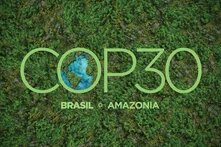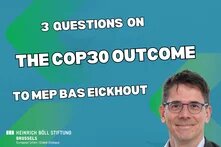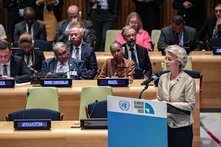Kenyan climate activist Elizabeth Wathuti gave an emotional speech at the World Leaders Summit of the ongoing COP26. She asked people to open their hearts as “if you allow yourselves to feel it, the heartbreak and the injustice is hard to bear.” Indeed, inequalities are striking in the climate crisis. Lisa Tostado unpacks them and reports on yesterday’s action on payment of climate debt.

It is the people who will and already do suffer from the climate crisis most and their moving speeches here at COP who bring to light the injustices and inequalities of the climate crisis to us. Take, Elizabeth Wathuti for example, who said that “right now, as you sit comfortably in this conference center in Glasgow, over 2 million of my fellow Kenyans are facing climate-related starvation. In this past year, both of our rainy seasons have failed. Our rivers are running dry, our storehouses stand empty, our animals and people are dying. I have seen with my own eyes, three young children crying at the sight of a dried up river after walking two and a half miles with their mother. Sub Saharan Africans are responsible for just half percent of historical emissions. The children are responsible for none. But they are bearing the brunt.“ She asked for a moment of compassionate silence “for the billions people who are not here with us today, whose stories are not being heard and whose suffering is not being felt”.
How many more voices, how many more pictures do we need to see on these screens? Are we so blinded and hardened that we can no longer the cries of humanity?
In my first report on my attendance at COP a few days ago, I broke down the gaps in needed emissions reductions and pledges as well as promised and delivered finance. “This gap is measured in lives and livelihoods. This is unmoral and it is unjust”, said Mia Mottley, Prime Minister of Barbados in her speech during COP26. Climate justice has become a common term, which most people will have heard of. You can hear activists chant it across the globe. "What do we want? Climate justice! When do we want it? Now!" It frames global heating as an ethical and political issue, rather than one that is purely physical in nature. In a nutshell, those that contributed least to the climate crisis are in large parts also those who will and already do suffer from it the most. The framework for breaking down that climate injustice is responsibility for emissions and the concept of vulnerability. This latter is a product of exposure and sensitivity to a climate impact and the adaptive capacity. While this may sound technical, it is worthwhile to understand these details to grasp the different interconnected dimensions of injustices.
Exposure refers to the degree to which ecosystems, people and things they value are exposed to climate change phenomena. Many poor countries are located in geographic areas in which impacts will be felt quicker and more severely, for example because their climates are already characterized by high temperatures and weather extremes. Even within countries, disadvantaged segments of society have different exposures. Construction workers spend most of their days outside and suffer more from extreme heat. Poorer households need cheap housing which they often find in for example flood-prone areas. As global heating is progressing, future generations are by definition more exposed to its effects.
Sensitivity is the degree to which ecosystems, people and the things they value could be harmed by exposure. It depends on many characteristics, such as health, gender, age, wealth and existing infrastructure in a country. The bodies of children, the elderly, or people with disabilities for example often react more severely to extreme temperatures. If a flood hits a city, the safety of citizens depends inter alia on warning systems in place, robust building infrastructure and emergency response measures. Women and girls are at increased risk of violence and abuse in the aftermath of a disaster.
For those who are wise to see, for those who have ears to listen and a heart to feel: 1.5 is what we need to survive. 2 degrees is a death sentence for the people of Antigua and Barbuda the Maldives, Dominica, Fiji, Kenya and Mozambique. And yes, for the people of Samoa and Barbados. We’ve come here today, to say: Try harder, try harder!”
Lastly, adaptive capacity describes the ability to adjust to climate changes and to cope with the consequences. Once again, resources play a major role, but also access and ability to process data for example or the ability to migrate which in turn has an important gender dimension. Many regions in the Global North are already spending millions on adapting to already observed or predicted climate change impacts, for example by building dikes.
There are inequality and justice elements within each of these. That also applies to the question of who caused the climate chaos. A recent Oxfam report based on research conducted with the Stockholm Environment Institute found that the richest one percent of the world’s population are responsible for more than twice as much carbon pollution as the 3.1 billion people who made up the poorest half of humanity between 1990 and 2015. The richest 10 percent accounted for over half of the emissions added to the atmosphere. In 2015, around half the emissions of the richest 10 percent - people with net income over $38,000 - are linked to citizens in the US and the EU. Apart from wealth, your generation will by definition say something about how much you have contributed to greenhouse gas levels in the atmosphere. There is also evidence that men tend to have a bigger carbon footprint than women.
According to a study in The Lancet Planetary Health, the United States and the EU are responsible for 40% and 29% respectively of the climate breakdown the world is experiencing today. In total, the Global North is responsible for 92% of excess global carbon emissions. The study is based on the idea that the atmosphere is part of the global commons and that all countries have a right to their fair share of emissions. Not only did many countries with disproportionate responsibilities rely on the appropriation of labour and resources from the Global South for their own economic growth, they have also relied on the appropriation of these global atmospheric commons, with consequences that harm the Global South disproportionately. Such findings could be the basis for reparation claims as excess emissions beyond planetary boundaries could be weighed against payments for loss and damage and adaptation. On today’s third day of COP26, activists asked governments of the Global North to deliver sufficient climate finance and pay reparations for the climate debt they owe the Global South (see an example of the twitter storm). It is interesting to note that for climate action to be just, the richest one percent must reduce their emissions by a factor 30 whereas the poorest 50% can actually increase emissions by a factor 3.
To me personally, the analysis and numbers above is not news and a major reason for which I started working on climate in the first place. Yet, talking to so many people who are victims of these injustices, listening to their emotional pleas addressed to richer nations to finally reduce emissions and provide finance for loss and damage, adaptation and mitigation, has brought me to a point where, indeed, “the heartbreak and the injustice is hard to bear”. I sincerely hope that this is the case for many people.


